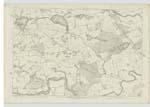OS1/25/16/54
| List of names as written | Various modes of spelling | Authorities for spelling | Situation | Description remarks |
|---|---|---|---|---|
| ISLAND OF CLUNIE | Island of Clunie Island of Clunie Island of Clunie The Island of the loch of Clunie The Island of the loch of Clunie |
Mr. James Gray Mr. William Duff Mr. James Fleming Fullarton's Gazetteer Dunkeld, its Straths & Glens |
063 | A small island in the loch of Clunie, partly artificial, on which stands a castle in good repair. It is also the site of St. Catherine's Chapel. Property of the Earl of Airly. "About 200 yards from its western shore is a beautiful little island on which is an old castle, formerly the residence of the Earls of Airlie, built by George Brown, Bishop of Dunkeld in the 16th century. The walls are 9 feet thick; an around the verge of this island are sprinkled a few old ash-trees and planes, which have withstood the storms of some hundred years, yet still continue to vegetate. *** The island itself is plain carpet of green, interspersed with a few flowering shrubs, where the fairies, in the times of superstition, were thought to hold their moonlight assemblies. *** The island itself is mostly artificial, if not altogether so. It must have been formed with great labour, and in some very distant period, as there is neither record nor tradition with respect to its formation. In papers dated 360 years ago, it is termed 'The Island of the Loch of Clunie'. The people in the neighbourhood affirm that it once joined on the south-east side to the mainland; but this is not at all probable, as the land there lies at a very considerable distance, with deep water intervening. Its surface is a circular plain, of about half-an-acre, raised a few feet above the ordinary level of the loch, and surmounted with a strong barrier of stones thrown carelessly together, and sloping into deep water all around, like the frustrum of a cone. That the island has been formed principally by human art seems demonstrable from this, that the ground of which it is composed is evidently factitious; and in digging to the depth of 7 feet, near the centre of the island, nothing like a natural stratum of earth appeared. The foundation of the castle-wall is several feet below the surface of the water, and in all likelihood rests on piles of oak" Fullarton's Gazetteer |
Continued entries/extra info
[Page] 54Perthshire -- Parish of Clunie
Transcribers who have contributed to this page.
Alison James- Moderator, Brenda Pollock
Location information for this page.
Linked mapsheets.




